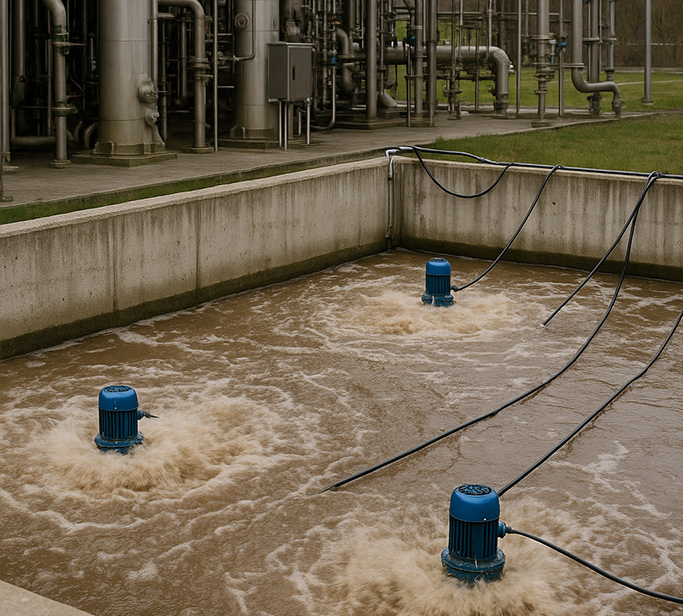TREATMENT OF AMMONIACAL WASTEWATER GENERATED IN THE THIN JUICE EVAPORATION PROCESS
In the technological process of sugar production, wastewater loaded with ammonia is generated. The significant volume of this wastewater causes additional load and disrupts the operation of the biological wastewater treatment plant. The aim is the selective capture of ammonia (NH3) and its conversion into a mineral fertilizer in the form of ammonium sulfate (NH4)2SO4.
Zero-discharge installation – eluate after bed regeneration: 10% solution of ammonium sulfate or diammonium phosphate.
Wastewater generated during thin juice evaporation negatively affects the operation of biological treatment plants. It disrupts their performance because ammonia adversely impacts the activated sludge, while the organic content is minimal. The large volume of ammonia-laden wastewater unnecessarily dilutes wastewater containing organics.
We propose separating the wastewater streams and treating the ammoniacal wastewater independently. In the treatment process, ammonia will be selectively captured, and the water can be safely discharged into the environment.
The eluate obtained after bed regeneration can be used as an additive for feed, fertilizers, or supplied to companies specializing in the production of such products.
Economic aspect – significant savings on fees for wastewater discharged to treatment plants and reduced operating costs of the local post-treatment facility.
Ecological aspect – water recovery of approximately 200 m³/h (amounting to 48,000 m³ during the sugar campaign).
SYSTEM ADVANTAGES
Each technology for managing or selectively treating liquids is individually developed to meet the client’s needs.
Every solution proposed by our company addresses specific loads and expected capacities – the only constant is the highest final efficiency.
In addition:
- Reliability and easy operation,
- Durability of filter media,
- Compact dimensions of the station,
- Utilization of eluate – closed water cycle.

TECHNOLOGY APPLICATION EXAMPLE
Przykładowe wyniki analiz wody amoniakalnej Oddziału Cukrowni
| Parameter | Unit | Range 1 | Range 2 |
|---|---|---|---|
| COD | mgO2/dm3 | 80–170 | 190–280 |
| pH | pH | 7.6–7.9 | 7.9–8.3 |
| Nitrate nitrogen | mgN-NO3/dm3 | 1.2–3.0 | 1.2–3.0 |
| Nitrite nitrogen | mgN-NO2/dm3 | 0.001–0.2 | 0.001–0.2 |
| Ammonium nitrogen | mgN-NH4/dm3 | 51.6–96.6 | 53.9–69.6 |
Amount of ammoniacal water:
1. Quantity 45–50% on beets
For a sugar factory processing 5,000 t.b. per day: amount of ammoniacal water 95–105 m³/h
For a sugar factory processing 9,000 t.b. per day: amount of ammoniacal water 170–190 m³/h
2. Water temperature approx. 60 °C
Station for 180 m³/h (170–190 m³/h)
- Triple DUO system: 3 x 2 filters
- Water volume per cycle / exchanger: 375 m³
- Cycle duration: 12 h 36 min
- Total regeneration time: 1 h 25 min
- Ammonium sulfate production: 84.24 kg/h
- Bed regeneration (1 exchanger)
Station for 100 m³/h (95–105 m³/h)
- Double DUO system: 2 x 2 filters
- Water volume per cycle / exchanger: 385.4 m³
- Cycle duration: 15 h 25 min
- Total regeneration time: 1 h 25 min
- Ammonium sulfate production: 46.8 kg/h
- Bed regeneration (1 exchanger)
AMMONIA (NH₃) RECOVERY STATION PROJECTS – GENERAL NOTES:
The system is based on capturing ammonia on ion exchange resins. Once the exchange capacity of the column is exhausted, it is washed with sulfuric acid (H2SO4), and the effluent contains ammonium sulfate (NH4)2SO4. To obtain it in solid, commercial form, e.g. as artificial fertilizer, it must be evaporated after neutralizing the effluent with ammonia.
NOTE:
- As a final product, ammonium nitrate (NH4NO3) could also be produced, but then the safety requirements during technological operations would be much stricter…
- It would also be possible not to evaporate the ammonium sulfate solution, but to provide it to farmers in liquid form, in order to reduce recovery costs.
It may also be used as a feed additive (approved by the European Union) and added to beet pulp.
- Recovery of sucrose from molasses. Molasses still contains a significant amount of sugar. In the past, it was entirely utilized in the fermentation industry or as an additive to animal feed. Currently, ion exchange techniques are used to recover sugar from molasses, which increases the efficiency of sugar extraction from beets in sugar factories. If of interest, we can provide information on this subject.



